#dutch warships
Text

The “Gouden Leeuw “ and “Zeven Provinciën” in front of Den Oever , Wieringen around 1670, by Jan de Quelery (1957-)
148 notes
·
View notes
Text

The Battle of Texel 1673 by Jan de Quelery
#battle of texel#battle of kijkduin#age of sail#art#jan de quelery#netherlands#england#michiel de ruyter#prince rupert#france#dutch republic#dutch#english#french#fleets#navy#royal navy#warship#warships#naval battle#naval warfare#history#europe#european#third anglo dutch war#franco dutch war#north sea#texel#royal prince#kijkduin
46 notes
·
View notes
Photo

Hoi @koninklijkemarine! 🇳🇱 The #Dutch #Navy visits #London #RoyalNetherlandsNavy #naval #warship #frigate #Netherlands (at London, United Kingdom) https://www.instagram.com/p/CmAH2VuNneX/?igshid=NGJjMDIxMWI=
0 notes
Text
NOBLE Team headcanons and other things I rotate in my mind
from the top:
The Team as a whole
holy shit did a lot of them die
like, until the final roster got locked in, NOBLEs three, four, and five would constantly drop like flies.
the final roster in question is also entirely made up of human cockroaches
it's basically already spelled out that NOBLE is a joint-ops team on loan from the Navy to the Army, but I like to think that their distance from ONI and the rest of the SPARTANs gives them a bit of street cred amongst the Shock Infantry battalions
NOBLE One, Commander Carter-A259
Carter was definitely the first person chosen to "be on" NOBLE Team, but he's not exactly the first member, if that makes any sense. does that make sense?
speaks with a Dutch accent because his homeworld was colonized by South Africans
He's a father figure to some of the others. In another life, he'd be wearing a 'Kiss the Cook' apron and would simply stay at home to take care of the kids while his high-powered girlboss wife goes to work
If he wasn't a SPARTAN, He'd probably still join the armed forces. I can see him as a high ranking non-com officer. maybe an ODST.
His rank!! So, in the UNSC command structure, a Commander usually has authority over a small line warship (usually a frigate). Not only that, but SPARTAN authority usually trumps that of most officers of the same rank. in summary, Carter's definitely pulled rank in order to commandeer a frigate at some point in his career. probably at Kat's request.
Runs the hottest body temp somehow
NOBLE Two, Lieutenant Commander Catherine-B320 "Kat"
She's the real first member of the team.
She absolutely got put there by Ackerson so Carter could keep her out of trouble and stop her from breaching his computer.
It did not work
Speaking of, she and Carter HATED each other for the first few months. I know this, it was revealed to me
They ended up getting fucking shitfaced together after a mission and talked all about their feelings and emotions so now she and Carter pretty much move in synch. they are drift compatible
She can hold her alcohol a lot better than he can though lmao
best at opening locked doors (hacking)
Kat is, most ironically, ambidextrous
She'd FOR SURE be an ODST if she wasn't a SPARTAN. She's too much of a high-powered girlboss to do anything remotely normal
NOBLE Three, Warrant Officer Jun-A266
somehow more catlike than the team member literally named that
likes to lay down on sunny rocks :)
also can't handle liquor for shit
best at opening locked doors (lockpicking)
would not be in the armed forces. he'd be some rich heiress' boytoy in the inner colonies.
...dare I say babygirl?
NOBLE Four (1), Warrant Officer Emile-A239
the only member not technically reassigned to the unit
they found him by pure coincidence half-dead, surrounded by corpses
Jun immediately pack-bonded with him
he's surprisingly kind of normal, actually. he just thinks skulls look cool
second physically strongest member of the team behind Jorge
best at opening locked doors (kicking them off their hinges)
sure, he could be a phenomenal ODST, but to be honest I think this guy would be a crewman on some support vessel in the Navy, maybe.
NOBLE Five, Chief Warrant Officer Jorge-052
second to last member of the final roster.
everyone else on the team initially thought that he'd been transferred in to replace Carter
not quite a father figure. More of an uncle, but not biologically - like it's mom's college friend but he still gets the title
went clean shaven randomly one time and gave Kat a heart attack
god could this man make a fucking stew
he'd probably work in a refugee assistance organization if he wasn't a SPARTAN.
NOBLE Six (1), Warrant Officer Thom-A293
not part of the original team, but got transferred like six months in
very cheerful guy
A bit of a yapper
friends with all sorts of animals but Carter doesn't let him keep any :(
if not a SPARTAN, he'd be a cartoonist
NOBLE Six (2), Lieutenant [REDACTED]-B312
if NOBLE Team is a found family, Six is the dog
Has a UNICOM rank instead of a NAVCOM rank specifically because Ackerson didn't want any oversight in Six's operations (also because bungie forgor)
Probably knows Halsey is Miranda Keyes' mom, or at least would if not for forgetting it.
kind of a dumbass because who needs to know shit if your job is killing people and blowing shit up???
#halo reach#NOBLE Team#kat b320#carter a259#jun a266#emile a239#jorge 052#thom a293#noble six#spartan b312#I didn't read the book that has Rosenda in it but I'm sure she's poggers#halo
14 notes
·
View notes
Text
ides of march

well, its tumblr's favorite holiday and who can blame us? The assassination of Julius Caesar is probably one of the only group projects that ever went down the way it was supposed to with, well, not complete group participation (there were said to be upward of 60 people involved but only 23 stab wounds - obviously someone was not carrying their weight) but at least a good effort was made at it. But lets take a moment, between our jokes about salad and Animal Crossing butterfly nets to look at what else has happened in history on the Ides of March. For instance, did you know, on March 15th:
1493 - Columbus returned to Spain after 'discovering' the new world.
1580 - Phillip II of Spain put a bounty on the head of Prince William I of Orange for 25,000 gold coins for leading the Dutch revolt against the Spanish Hamburgs
1744 - King Louis XV of France declares war on Britain
1767 - Andrew Jackson, who would go on to be the seventh president of the US, was born.
1820 - Maine became the 23rd state in the US
1864 - the Red River Campaign, called 'One damn blunder from beginning to end' started for the Union Forces in the American Civil War
1889 - a typhoon in Apia Harbor, Samoa sinks 6 US and German warships, killing 200
1917 - Czar Nicholas II abdicated the Russian throne, bringing an end to the Romanov dynasty
1955 - the first self-guided missile is introduced by the US Air Force
1965 - TGI Friday's opens its first restaurant in New York City
1991 - in LA, four police officers are brought up on charges for the beating of Rodney King
2018 - Toys R Us announces it will be closing all its stores
2019 - a terrorist attacks two mosques in Christchurch, New Zealand, killing 51, and wounding 50 others
Oof! Pretty bleak, isn't it? It would almost make you think that the day is just bad luck, start to finish and its probably just as well, we're all focusing on assassination instead of other horrors. But wait - its not all bad news! The Ides of March has some tricks up its sleeve yet (joke intended). I'd be telling you only half the story if I didn't add:
1854 - Emil von Behring is born and will eventually become the first to receive the Nobel Prize in medicine for his discovery of a diphtheria antitoxin, being called 'the children's savoir' for the lives it saves
1867 - Michigan is the first state to use property tax to support a university
1868 - the Cincinnati Red Stockings have ten salaried players, making them the first professional baseball team in the US
1887 - Michigan has the first salaried fish and game warden
1892 - the first automatic ballot voting machine is unveiled in New York City
1907 - Finland gives women the right to vote, becoming the first to do so in Europe
1933 - Ruth Bader Ginsberg is born and will go on to become a US Supreme Court justice
1934 - the 5$ a day wage was introduced by Henry Ford, forcing other companies to raise their wages as well or lose their workers
1937 - the first state sponsored contraceptive clinic in the US opens in Raleigh, North Carolina
1946 - the British Prime minister recognizes India's independence
1947 - the US Navy has its first black commissioned officer, John Lee
1949 - clothes rationing ends in Britain, four years after the end of WWII
1960 - ten nations meet in Geneva for disarmament talks
1968 - the Dioceses of Rome says it will not ban 'rock and roll' from being played during mass but that it deplores the practice - also in 1968, LIFE magazine titles Jimi Hendrix 'the most spectacular guitarist in the world'
1971 - ARPANET, the precursor of the modern day internet, sees its first forum
1984 - Tanzanian adopts a constitution
1985 - symbolics.com, the first internet domain name, is registered
The Ides of March turns out to just be a day, like any other day in history.
Unless you're us. In which case -

#ides of march#happy ides of march#julius caesar#today in history#please take some of my 'bad' dates as tongue in cheek#we love you maine#and a few of my dates fit both the good and bad side of the things so I just went with whichever I was on at the time#feel free to wiggle them around to a more appropriate column
14 notes
·
View notes
Text

France has Mirage 2000D fighter-bombers left over and Ukraine wants them
It is no wonder that rumors continue to circulate around France, Ukraine and the Dassault Mirage 2000D fighter bomber.
Fernando Valduga By Fernando Valduga 02/09/2024 - 15:41in Military, War Zones
Ukraine needs warplanes. France is retiring some of its Delta Mirage 2000D. And the French government has already promised Ukraine the best precision-guided ammunition from the Mirage.
If France is really going to donate Mirages, the announcement may occur soon. French President Emmanuel Macron is expected to visit Ukraine this month.
It is obvious that Ukraine would want some of the Mirage 2000D left over from the French air force. Supersonic, single-engine and two-seater Mirages are fully compatible with SCALP-EG cruise missiles and Hammer smart pumps. The first missile model is already in use in Ukraine; the Hammer will arrive soon.
The French Air Force acquired 86 Mirage 2000D fighters from the manufacturer Dassault and, after three decades of intense use during which several jets fell, it chose to upgrade 55 of the jets for service by the 2030s. This leaves about 20 of the planes that are surplus for France's needs.

Ukrainian authorities have been keeping an eye on this type while working with Danish, Dutch and Norwegian authorities to acquire dozens of surplus European Lockheed Martin F-16s – and qualify Ukrainian pilots in single-seater fighters in the United States and Romania.
“It is possible that the combat capabilities of the Su-24M bombers will be improved by the Mirage 2000D,” Ukrainian Air Force commander Lieutenant General Mykola Oleshchuk wrote last month.
Oleshchuk is not wrong in linking the French fighter to the existing Sukhoi Su-24M bombers in his air force. The variable geometry sukhois are the main long-range attack aircraft of the Ukrainian Air Force.
Firing British-made Storm Shadow and French SCALP cruise missiles at a range of about 320 kilometers, the Su-24 blew up Russian navy warships, attacked Russian air bases, knocked down bridges in Russian-occupied territories and destroyed Russian headquarters.

France gave Ukraine about 50 of the SCALPs of 2,900 pounds in 2023 and recently promised another 40. However, the United Kingdom donated an unspecified number of similar Storm Shadows - probably dozens of copies.
However, the Ukrainians have few bombers. The only Su-24M unit of the Air Force, the 7ª Tactical Aviation Brigade in Starokostiantyniv, western Ukraine, went to war in February 2022 with probably two dozen Sukhois. In 23 months of hard fighting, according to the Oryx website, he lost 18 of the bombers.
Although it is possible that Ukrainian technicians can bring back to flight status some of the dozens of abandoned Su-24s that were mofing in open storage in several aircraft cemeteries throughout Ukraine, there is another way to restore the strength of the front line of the 7ª Brigade: to give it the Mirage 2000D.
Yes, French jets would need new logistics infrastructure. Yes, Sukhoi crews may have to spend months qualifying for the Mirages. The investment may be worth it, however.
On the one hand, it is increasingly unlikely that Ukraine will obtain surplus warplanes from the United States. Republicans aligned with Russia in the U.S. Congress blocked more aid to Ukraine for months. If the Ukrainian air force intends to rearm itself, it should do so with European planes.
In addition, the Mirages may reach Ukraine shortly after Ukraine also receives a large shipment - hundreds, according to Macron - of bombs driven by Hammer rockets, each with a range of up to 55 kilometers.

The Hammers, which come in 276, 1,100 and 2,200 pounds versions with a variety of search engine options. They are comparable to the Joint Direct Attack Munition gliding bombs that the United States gave to Ukraine before the Republicans cut the aid, and that the Ukrainians installed on their former Mikoyan MiG-29 fighters.
Where it takes time and effort to integrate a new Western ammunition into a Soviet-made Sukhoi or MiG warplane, the Mirage 2000D has been compatible with Hammer bombs since the ammunition debuted in French service in 2007.
Source: Forbes
Tags: Armée de l'air - French Air Force/French Air ForceMilitary AviationMirage 2000DWar Zones - Russia/Ukraine
Sharing
tweet
Fernando Valduga
Fernando Valduga
Aviation photographer and pilot since 1992, he has participated in several events and air operations, such as Cruzex, AirVenture, Dayton Airshow and FIDAE. He has works published in specialized aviation magazines in Brazil and abroad. He uses Canon equipment during his photographic work in the world of aviation.
Related news
EMBRAER
Embraer and Mahindra announce collaboration for the C-390 Millennium in India
09/02/2024 - 11:03
HELICOPTERS
U.S. Army cancels FARA program after observations on Ukraine's battlefield
09/02/2024 - 10:22
EMBRAER
IMAGES: Hungary's first Embraer C-390 Millennium is
09/02/2024 - 09:09
MILITARY
Greece evaluates sale of Mirage 2000 jets to India
08/02/2024 - 19:28
HELICOPTERS
France buys more NH90 helicopters for its Special Operations Forces
08/02/2024 - 18:25
MILITARY
Ukraine launches new 'Kamikaze' jet drone against Russia
08/02/2024 - 17:15
homeMain PageEditorialsINFORMATIONeventsCooperateSpecialitiesadvertiseabout
Cavok Brazil - Digital Tchê Web Creation
Commercial
Executive
Helicopters
HISTORY
Military
Brazilian Air Force
Space
Specialities
Cavok Brazil - Digital Tchê Web Creation
10 notes
·
View notes
Text
Addams Family Tree & History

I'm sick with the flu and still grieving, so I decided to remake the Addams Family tree (lol excuse the tacky graphic design) and write down their fictional history based on all of the references to their ancestors. Some of the placements of relatives here are speculative, based on the time they lived in and so on.
Pre-1600s
The many iterations of the Addams Family provides several information on the history of the fictional family. The eldest known ancestor of the Addams family is probably the ghostly caveman featured in the musical and Mamoud Khali Pasha Addams, who was called the Firebug of the Bosporus that burned the Library of Alexandria down in 270 AD. Around the Dark Ages, an ancestor named Rulen the Ruthless Addams existed.
1600s
The earliest appearance of an ancestor was one that was featured prominently in Wednesday (series). Goody Addams and her mother lived in Jericho, Vermont during the witch trials of 1625 and were of Mexican descent, having lived among the native folk for a long time. When the town founder Joseph Crackstone set those accused of withcraft on fire, Goody escaped. Goody is not mentioned to be a direct ancestor, so it is possible that she may be the sister of one of Wednesday's ancestors.
A year later, in 1626, a Dutch man by the name of Van Dyke Addams helped in buying Manhattan from the natives of New York. Though Gomez claimed him to be his great-great-great-great-grandfather, this is not plausible because of Long John (see below), who existed in the latter part of the 1600s. Given the timeline, it's possible that Van Dyke was actually the grandfather of Long John and the father of Goody.
In the The New Addams Family, Long John Addams, Gomez's great-great-great-great-great-grandfather was a pirate and in 1699 wrote a story about his life. He had a brother named Curly Addams, whose severed hand became Pinky (presumably an ancestor of Thing) and Long John later married Lady Penelope Addams, who was actually a dread pirate that was his rival and sought someone to best her.
1700s
In the early 1700s, an aunt by the name of Calpurnia Addams danced naked in the town square and enslaved a minister, and was burned as a witch in 1706.
According to Gomez in the musical in July 31st, 1715, a man named Captain General Redondo Cuervo (short for Redondo Ventana Laguna Don Jose Cuervo), who commanded a Spanish warship named Pico de Gallo, sailed from Madrid, but was still stuck there three weeks later. He sank six months later off the southern coast of Florida and presumably settled there. It was not mentioned that he was a direct ancestor by Gomez and he did not bear the name of Addams, so it's possible that he might have come from a maternal line.
A woman by the name of Miss Salem Addams was born in 1730 and lived up until 1830, and was buried in the family cemetery.
In 1764, an Admiral John Paul Addams was apparently hanged, but he was also apparently responsible for 'the shot heard round the world' in 1775, which began the American Revolutionary War, and for fighting against Hideki Tojo's forces and the German flotilla in the North Atlantic sea during World War II.
It can be inferred that he was possibly the captain of a ghost ship, considering that he had died in the mid 1700s and was yet active in the 1940s. It is possible that he was Gomez's great-great-great-great-grandfather.
Another relative who appeared in the American Revolutionary War was Old Cannonball Addams, who was said to be a natural-born leader at Bunker Hill in 1775 before he began firing at his own men due to him not being able to see without his glasses. An Addams that possibly lived in this generation as well was Blood and Guts Addams, who may also have been in the American Revolutionary War.
During the 1700s, apparently a branch of the family split into the famous Adams political family in Boston, Massachussetts, of which Gomez's distant cousin by marriage, Abigail Adams, is a member of and sees herself as the head of the family.
1800s
Around this time, Ol' Ebenezer Addams led early settlers to the Great Plains and sold the first guns to the Native Americans (it is possible that he was Gomez's great-great-great-grandfather). Later on, Old Blood and Thunder Addams participated in the American Civil War and was very inspirational right before he turned traitor at Shiloh in 1862, while in 1863, General Ulysses S. Addams surrendered in Vicksburg after enemy soldiers caught up with him.
Then presumably in c.1860-1870, Gomez's great-great-grandfather, Goober Addams (according to Gomez in the 1992 series) built The Addams Family Mansion in order to enjoy the swamp. It is possible that Goober was a sibling of Blood and Thunder and Ulysses, and the son of Ebenezer.
His presumable son, Pegleg Addams, was Gomez's great-grandfather (mentioned in the 1964 series), who was the last of the adventureous Addams and was wanted by fifteen countries for piracy. He had hid the treasure under the mansion. It was possible that he had siblings by the name of Bluebeard Addams, Black Bart Addams, and Bloody Addams, who were presumably pirates too.
1900s
Pegleg had at least one son, Mortimer Addams, a pyromaniac who resembled Gomez and married Delilah Addams. Delilah is possibly the daughter of Grandpa Squint, a medical expert of some kind who Abraham Lincoln begged for his political support in the 1860s, and Grandma Squint, who often makes strange sounds and cackles from the attic on dark stormy nights.
It was possible that Pegleg had another son named Uncle Blight, who masterminded the presidential campaigns of Al Smith, Wendell Wilkie, and Adlai Stevenson in 1928, 1940, and 1952 (respectively). Additionally, a relative by the name of Edwin Booth Addams was presumably named after the killer of Abraham Lincoln, and could possibly be a relative of them.
Mortimer and Delilah visited the family in Addams Family Reunion, in which they showed symptoms for Waltzheimer's Disease and became pleasant old people. By the time of The New Addams Family, Delilah had died by being struck by a truck while rollerblading with headphones on. Mortimer later married Diandra Addams, who resembled Morticia.
Mortimer's son was Father Addams (possibly named Harold) who later married Grandmama (or Mother Addams), and they had four children: Gomez Addams, Pancho Addams, and Uncle Cosimo, Uncle Fester. They spent some time in Spain (Gomez calls it his 'ancestral land') as it was mentioned that Gomez lived there until he was 10 and a marriage was arranged by Mortimer (who signed the marriage contract) and Don Xavier Molina between Gomez and Consuela, Don Xavier's daughter. Their families were said to have known each other since the time of the Spanish inquisition. According to Morticia in the 1991 film, both Mother and Father Addams later died in the hands of an angry mob.
Present time
In Wednesday, Gomez and Morticia both attended Nevermore Academy for their high school, and that is where they met in 1997.
In The Addams Family (TV Series) and The New Addams Family, Granny Frump and Grandmama had planned to marry Morticia's older sister Ophelia Frump to Gomez, but the plan failed when Gomez fell in love with Morticia instead. Beforehand, Morticia had been dating Gomez' cousin Cousin Vlad, since they had gone to the same high school, and Gomez and Morticia had first met at a funeral, but only gotten to know each other better around the time of Ophelia and Gomez's matchmaking.
After they married at the age of 22, they had three children: Wednesday Addams, Pugsley Addams, and later, in Addams Family Values, Pubert Addams. There were also two other children in the Halloween special named Wednesday Jr. Addams and Pugsley Jr. Addams, but they are often not considered canon.
They live in the crumbling Addams Family mansion with their butler, Lurch, who had presumably been in the family for a long time. His father, Father Lurch, a Dr. Frankenstein-like character, put him together and wanted him to be a jockey, and he has a very smothering mother by the name of Mother Lurch. Gomez said that Lurch has the heart of an Addams and it is implied to be literal. Lurch apparently came from a long line of similar looking, hulking people. in the 2019 film, Lurch was a former inmate at the insane asylum that became the family mansion.
Another member of the household is Thing (or his full name, Thing T. Thing). Though he is sometimes portrayed as having been a hand creature born from a long line of hands (a photograph of his parents appears in the 1964 series, as a female hand holding a male hand), other portrayals have him as a disembodied hand, possibly of a member of a family. Indeed, in the original cartoons, Thing was shown to be a creature with a body who often appears in the peripherals of the illustrations. He then became an arm and later on, only a hand.
Grandmama's Branch
The oldest known ancestor from Grandmama's side of the family was her great-great-great-grandmother Slice, who sharpened guillotines and was called 'the belle of the French Revolution' in 1789-1799.
Not much is known about her branch of the family, but it was known that she came from a family of witches. Her mother was presumably called Mooma, who would run her kids out of town if they ever got too big for their brooms, while her father was presumably Grandpa Slurp, who had two heads: with a bucktooth in one head, and a receding chin on the other.
She was also known to have two siblings: Uncle Jester, a zany, trouble-making jester who resembled Fester (and who she greatly disliked), and Great Auntie Sloom, who was looked at as a family elder who presided over the family traditions (such as the Mazurka). It can be inferred, then, that Grandmama's family and the main Addams family have their traditions intertwined.
She had a dark complexion (in the original illustrations and the 2020s films) and was known to have gone to a high school named Swamptown High with Granny Frump. In the 2020s film, she often travels the world and has an Old World, Eastern-European accent, the first iteration that showed her to be of a non-American origin.
The Frump Branch
Morticia's great-great-great-Aunt Singe was said to be burned during the Salem Witch Trials of 1892-1893, placing her as the oldest known ancestor of the Frump family. Another possible relative from this time would be Great-Aunt Esther.
Morticia was known to have a grandfather named Grandpa Droop, who gave her stock certicifactes for her twelfth birthday, implying they were rich. He may presumably be the father of Morticia's father, Grandpa Frump or her mother, Granny Frump. Grandpa and Granny had fallen in love because Fester (here as Grandpa's brother, in the 1964 series) shot the arrow (and the gun) that brought them together. They had two children: Ophelia Frump and Morticia.
Granny was a witch and presumably, Morticia's ancestors were also witches. Because of Morticia's anti-social tendencies, Granny had to homeschool her and taught her everything. Morticia has an assortment of cousins with eccentric behaviors, such as the sisters Cousin Melancholia and Cousin Catastrophia, and Cousin Pretensia.
#the addams family#gomez addams#morticia addams#wednesday addams#pugsley addams#grandmama#eudora addams#grandmama addams#uncle fester#fester addams#lurch#thing#charles addams
65 notes
·
View notes
Text
A warship employed in the Anglo-Dutch wars of the 17th century has been identified as a wreck off the coast of Eastbourne, England. So what brought this machine of war to the seabed, and why was that instrumental in starting the Third Anglo-Dutch War?
33 notes
·
View notes
Text
Soaked in Seaweed: or, Upset in the Ocean.
(An Old-fashioned Sea Story)
by Stephen Leacock
It was in August in 1867 that I stepped on board the deck of the Saucy Sally, lying in dock at Gravesend, to fill the berth of second mate.
Let me first say a word about myself.
I was a tall, handsome young fellow, squarely and powerfully built, bronzed by the sun and the moon (and even copper-coloured in spots from the effect of the stars), and with a face in which honesty, intelligence, and exceptional brain power were combined with Christianity, simplicity, and modesty.
As I stepped on the deck I could not help a slight feeling of triumph, as I caught sight of my sailor-like features reflected in a tar-barrel that stood beside the mast, while a little later I could scarcely repress a sense of gratification as I noticed them reflected again in a bucket of bilge water.
“Welcome on board, Mr. Blowhard,” called out Captain Bilge, stepping out of the binnacle and shaking hands across the taffrail.
I saw before me a fine sailor-like man of from thirty to sixty, clean-shaven, except for an enormous pair of whiskers, a heavy beard, and a thick moustache, powerful in build, and carrying his beam well aft, in a pair of broad duck trousers across the back of which there would have been room to write a history of the British Navy.
Beside him were the first and third mates, both of them being quiet men of poor stature, who looked at Captain Bilge with what seemed to me an apprehensive expression in their eyes.
The vessel was on the eve of departure. Her deck presented that scene of bustle and alacrity dear to the sailor’s heart. Men were busy nailing up the masts, hanging the bowsprit over the side, varnishing the lee-scuppers and pouring hot tar down the companion-way.
Captain Bilge, with a megaphone to his lips, kept calling out to the men in his rough sailor fashion:
“Now, then, don’t over-exert yourselves, gentlemen. Remember, please, that we have plenty of time. Keep out of the sun as much as you can. Step carefully in the rigging there, Jones; I fear it’s just a little high for you. Tut, tut, Williams, don’t get yourself so dirty with that tar, you won’t look fit to be seen.”
I stood leaning over the gaff of the mainsail and thinking—yes, thinking, dear reader, of my mother. I hope that you will think none the less of me for that. Whenever things look dark, I lean up against something and think of mother. If they get positively black, I stand on one leg and think of father. After that I can face anything.
Did I think, too, of another, younger than mother and fairer than father? Yes, I did. “Bear up, darling,” I had whispered as she nestled her head beneath my oilskins and kicked out backward with one heel in the agony of her girlish grief, “in five years the voyage will be over, and after three more like it, I shall come back with money enough to buy a second-hand fishing-net and settle down on shore.”
Meantime the ship’s preparations were complete. The masts were all in position, the sails nailed up, and men with axes were busily chopping away the gangway.
“All ready?” called the Captain.
“Aye, aye, sir.”
“Then hoist the anchor in board and send a man down with the key to open the bar.”
Opening the bar! the last sad rite of departure. How often in my voyages have I seen it; the little group of men soon to be exiled from their home, standing about with saddened faces, waiting to see the man with the key open the bar—held there by some strange fascination.
Next morning with a fair wind astern we had buzzed around the corner of England and were running down the Channel.
I know no finer sight, for those who have never seen it, than the English Channel. It is the highway of the world. Ships of all nations are passing up and down, Dutch, Scotch, Venezuelan, and even American.
Chinese junks rush to and fro. Warships, motor yachts, icebergs, and lumber rafts are everywhere. If I add to this fact that so thick a fog hangs over it that it is entirely hidden from sight, my readers can form some idea of the majesty of the scene.
We had now been three days at sea. My first sea-sickness was wearing off, and I thought less of father.
On the third morning Captain Bilge descended to my cabin.
“Mr. Blowhard,” he said, “I must ask you to stand double watches.”
“What is the matter?” I inquired.
“The two other mates have fallen overboard,” he said uneasily, and avoiding my eye.
I contented myself with saying, “Very good, sir,” but I could not help thinking it a trifle odd that both the mates should have fallen overboard in the same night.
Surely there was some mystery in this.
Two mornings later the Captain appeared at the breakfast-table with the same shifting and uneasy look in his eye.
“Anything wrong, sir?” I asked.
“Yes,” he answered, trying to appear at ease and twisting a fried egg to and fro between his fingers with such nervous force as almost to break it in two—“I regret to say that we have lost the bosun.”
“The bosun!” I cried.
“Yes,” said Captain Bilge more quietly, “he is overboard. I blame myself for it, partly. It was early this morning. I was holding him up in my arms to look at an iceberg, and, quite accidentally I assure you—I dropped him overboard.”
“Captain Bilge,” I asked, “have you taken any steps to recover him?”
“Not as yet,” he replied uneasily.
I looked at him fixedly, but said nothing.
Ten days passed.
The mystery thickened. On Thursday two men of the starboard watch were reported missing. On Friday the carpenter’s assistant disappeared. On the night of Saturday a circumstance occurred which, slight as it was, gave me some clue as to what was happening.
As I stood at the wheel about midnight, I saw the Captain approach in the darkness carrying the cabin-boy by the hind leg. The lad was a bright little fellow, whose merry disposition had already endeared him to me, and I watched with some interest to see what the Captain would do to him. Arrived at the stern of the vessel, Captain Bilge looked cautiously around a moment and then dropped the boy into the sea. For a brief instant the lad’s head appeared in the phosphorus of the waves. The Captain threw a boot at him, sighed deeply, and went below.
Here then was the key to the mystery! The Captain was throwing the crew overboard. Next morning we met at breakfast as usual.
“Poor little Williams has fallen overboard,” said the Captain, seizing a strip of ship’s bacon and tearing at it with his teeth as if he almost meant to eat it.
“Captain,” I said, greatly excited, stabbing at a ship’s loaf in my agitation with such ferocity as almost to drive my knife into it—“You threw that boy overboard!”
“I did,” said Captain Bilge, grown suddenly quiet, “I threw them all over and intend to throw the rest. Listen, Blowhard, you are young, ambitious, and trustworthy. I will confide in you.”
Perfectly calm now, he stepped to a locker, rummaged in it a moment, and drew out a faded piece of yellow parchment, which he spread on the table. It was a map or chart. In the centre of it was a circle. In the middle of the circle was a small dot and a letter T, while at one side of the map was a letter N, and against it on the other side a letter S.
“What is this?” I asked.
“Can you not guess?” queried Captain Bilge. “It is a desert island.”
“Ah!” I rejoined with a sudden flash of intuition, “and N is for North and S is for South.”
“Blowhard,” said the Captain, striking the table with such force as to cause a loaf of ship’s bread to bounce up and down three or four times, “you’ve struck it. That part of it had not yet occurred to me.”
“And the letter T?” I asked.
“The treasure, the buried treasure,” said the Captain, and turning the map over he read from the back of it—“The point T indicates the spot where the treasure is buried under the sand; it consists of half a million Spanish dollars, and is buried in a brown leather dress-suit case.”
“And where is the island?” I inquired, mad with excitement.
“That I do not know,” said the Captain. “I intend to sail up and down the parallels of latitude until I find it.”
“And meantime?”
“Meantime, the first thing to do is to reduce the number of the crew so as to have fewer hands to divide among. Come, come,” he added in a burst of frankness which made me love the man in spite of his shortcomings, “will you join me in this? We’ll throw them all over, keeping the cook to the last, dig up the treasure, and be rich for the rest of our lives.”
Reader, do you blame me if I said yes? I was young, ardent, ambitious, full of bright hopes and boyish enthusiasm.
“Captain Bilge,” I said, putting my hand in his, “I am yours.”
“Good,” he said, “now go forward to the forecastle and get an idea what the men are thinking.”
I went forward to the men’s quarters—a plain room in the front of the ship, with only a rough carpet on the floor, a few simple arm-chairs, writing-desks, spittoons of a plain pattern, and small brass beds with blue-and-green screens. It was Sunday morning, and the men were mostly sitting about in their dressing-gowns.
They rose as I entered and curtseyed.
“Sir,” said Tompkins, the bosun’s mate, “I think it my duty to tell you that there is a great deal of dissatisfaction among the men.”
Several of the men nodded.
“They don’t like the way the men keep going overboard,” he continued, his voice rising to a tone of uncontrolled passion. “It is positively absurd, sir, and if you will allow me to say so, the men are far from pleased.”
“Tompkins,” I said sternly, “you must understand that my position will not allow me to listen to mutinous language of this sort.”
I returned to the Captain. “I think the men mean mutiny,” I said.
“Good,” said Captain Bilge, rubbing his hands, “that will get rid of a lot of them, and of course,” he added musingly, looking out of the broad old-fashioned port-hole at the stern of the cabin, at the heaving waves of the South Atlantic, “I am expecting pirates at any time, and that will take out quite a few of them. However”—and here he pressed the bell for a cabin-boy—“kindly ask Mr. Tompkins to step this way.”
“Tompkins,” said the Captain as the bosun’s mate entered, “be good enough to stand on the locker and stick your head through the stern port-hole, and tell me what you think of the weather.”
“Aye, aye, sir,” replied the tar with a simplicity which caused us to exchange a quiet smile.
Tompkins stood on the locker and put his head and shoulders out of the port.
Taking a leg each we pushed him through. We heard him plump into the sea.
“Tompkins was easy,” said Captain Bilge. “Excuse me as I enter his death in the log.”
“Yes,” he continued presently, “it will be a great help if they mutiny. I suppose they will, sooner or later. It’s customary to do so. But I shall take no step to precipitate it until we have first fallen in with pirates. I am expecting them in these latitudes at any time. Meantime, Mr. Blowhard,” he said, rising, “if you can continue to drop overboard one or two more each week, I shall feel extremely grateful.”
Three days later we rounded the Cape of Good Hope and entered upon the inky waters of the Indian Ocean. Our course lay now in zigzags and, the weather being favourable, we sailed up and down at a furious rate over a sea as calm as glass.
On the fourth day a pirate ship appeared. Reader, I do not know if you have ever seen a pirate ship. The sight was one to appal the stoutest heart. The entire ship was painted black, a black flag hung at the masthead, the sails were black, and on the deck people dressed all in black walked up and down arm-in-arm. The words “Pirate Ship” were painted in white letters on the bow. At the sight of it our crew were visibly cowed. It was a spectacle that would have cowed a dog.
The two ships were brought side by side. They were then lashed tightly together with bag string and binder twine, and a gang plank laid between them. In a moment the pirates swarmed upon our deck, rolling their eyes, gnashing their teeth and filing their nails.
Then the fight began. It lasted two hours—with fifteen minutes off for lunch. It was awful. The men grappled with one another, kicked one another from behind, slapped one another across the face, and in many cases completely lost their temper and tried to bite one another. I noticed one gigantic fellow brandishing a knotted towel, and striking right and left among our men, until Captain Bilge rushed at him and struck him flat across the mouth with a banana skin.
At the end of two hours, by mutual consent, the fight was declared a draw. The points standing at sixty-one and a half against sixty-two.
The ships were unlashed, and with three cheers from each crew, were headed on their way.
“Now, then,” said the Captain to me aside, “let us see how many of the crew are sufficiently exhausted to be thrown overboard.”
He went below. In a few minutes he reappeared, his face deadly pale. “Blowhard,” he said, “the ship is sinking. One of the pirates (sheer accident, of course, I blame no one) has kicked a hole in the side. Let us sound the well.”
We put our ear to the ship’s well. It sounded like water.
The men were put to the pumps and worked with the frenzied effort which only those who have been drowned in a sinking ship can understand.
At six p.m. the well marked one half an inch of water, at nightfall three-quarters of an inch, and at daybreak, after a night of unremitting toil, seven-eighths of an inch.
By noon of the next day the water had risen to fifteen-sixteenths of an inch, and on the next night the sounding showed thirty-one thirty-seconds of an inch of water in the hold. The situation was desperate. At this rate of increase few, if any, could tell where it would rise to in a few days.
That night the Captain called me to his cabin. He had a book of mathematical tables in front of him, and great sheets of vulgar fractions littered the floor on all sides.
“The ship is bound to sink,” he said, “in fact, Blowhard, she is sinking. I can prove it. It may be six months or it may take years, but if she goes on like this, sink she must. There is nothing for it but to abandon her.”
That night, in the dead of darkness, while the crew were busy at the pumps, the Captain and I built a raft.
Unobserved we cut down the masts, chopped them into suitable lengths, laid them crosswise in a pile and lashed them tightly together with bootlaces.
Hastily we threw on board a couple of boxes of food and bottles of drinking fluid, a sextant, a chronometer, a gas-meter, a bicycle pump and a few other scientific instruments. Then taking advantage of a roll in the motion of the ship, we launched the raft, lowered ourselves upon a line, and under cover of the heavy dark of a tropical night, we paddled away from the doomed vessel.
The break of day found us a tiny speck on the Indian Ocean. We looked about as big as this (.).
In the morning, after dressing, and shaving as best we could, we opened our box of food and drink.
Then came the awful horror of our situation.
One by one the Captain took from the box the square blue tins of canned beef which it contained. We counted fifty-two in all. Anxiously and with drawn faces we watched until the last can was lifted from the box. A single thought was in our minds. When the end came the Captain stood up on the raft with wild eyes staring at the sky.
“The can-opener!” he shrieked, “just Heaven, the can-opener.” He fell prostrate.
Meantime, with trembling hands, I opened the box of bottles. It contained lager beer bottles, each with a patent tin top. One by one I took them out. There were fifty-two in all. As I withdrew the last one and saw the empty box before me, I shroke out—“The thing! the thing! oh, merciful Heaven! The thing you open them with!”
I fell prostrate upon the Captain.
We awoke to find ourselves still a mere speck upon the ocean. We felt even smaller than before.
Over us was the burnished copper sky of the tropics. The heavy, leaden sea lapped the sides of the raft. All about us was a litter of corn beef cans and lager beer bottles. Our sufferings in the ensuing days were indescribable. We beat and thumped at the cans with our fists. Even at the risk of spoiling the tins for ever we hammered them fiercely against the raft. We stamped on them, bit at them and swore at them. We pulled and clawed at the bottles with our hands, and chipped and knocked them against the cans, regardless even of breaking the glass and ruining the bottles.
It was futile.
Then day after day we sat in moody silence, gnawed with hunger, with nothing to read, nothing to smoke, and practically nothing to talk about.
On the tenth day the Captain broke silence.
“Get ready the lots, Blowhard,” he said. “It’s got to come to that.”
“Yes,” I answered drearily, “we’re getting thinner every day.”
Then, with the awful prospect of cannibalism before us, we drew lots.
I prepared the lots and held them to the Captain. He drew the longer one.
“Which does that mean,” he asked, trembling between hope and despair. “Do I win?”
“No, Bilge,” I said sadly, “you lose.”
But I mustn’t dwell on the days that followed—the long quiet days of lazy dreaming on the raft, during which I slowly built up my strength, which had been shattered by privation. They were days, dear reader, of deep and quiet peace, and yet I cannot recall them without shedding a tear for the brave man who made them what they were.
It was on the fifth day after that I was awakened from a sound sleep by the bumping of the raft against the shore. I had eaten perhaps overheartily, and had not observed the vicinity of land.
Before me was an island, the circular shape of which, with its low, sandy shore, recalled at once its identity.
“The treasure island,” I cried, “at last I am rewarded for all my heroism.”
In a fever of haste I rushed to the centre of the island. What was the sight that confronted me? A great hollow scooped in the sand, an empty dress-suit case lying beside it, and on a ship’s plank driven deep into the sand, the legend, “Saucy Sally, October, 1867.” So! the miscreants had made good the vessel, headed it for the island of whose existence they must have learned from the chart we so carelessly left upon the cabin table, and had plundered poor Bilge and me of our well-earned treasure!
Sick with the sense of human ingratitude I sank upon the sand.
The island became my home.
There I eked out a miserable existence, feeding on sand and gravel and dressing myself in cactus plants. Years passed. Eating sand and mud slowly undermined my robust constitution. I fell ill. I died. I buried myself.
Would that others who write sea stories would do as much.
6 notes
·
View notes
Note
How do you respond to the serious allegations made in the 1653 pamphlet "The Dutch-mens pedigree: or A relation, shewing how they were first bred, and descended from a horse-turd, which was enclosed in a butter-box. Together with a most exact descripton of that great, huge, large, horrible, terrible, hideous, fearful, filthy, monstrous, misshapen, prodigious, preposterous horse that shit the same turd..."?
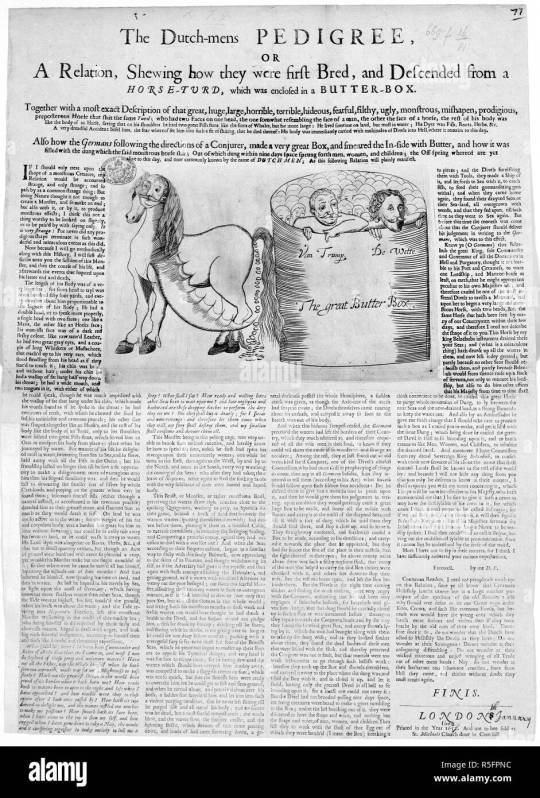
Well, see, if one needs this many words to express one's disdain for the Dutchmen, I am left with no recourse but to assume one got their breeches in a twist because the Republic capturing those English bottoms with its smaller, more manoeuvrable warships showed the Commonwealth how it's done.
32 notes
·
View notes
Text

Ships becalmed - With the Dutch “Walcheren “ on the left and the “Huis van Zwieten” [ right] build in 1653, by Jan de Quelery (1957-)
52 notes
·
View notes
Text

The Raid on the Medway, 1667 by Willem Schellinks
#willem schellinks#art#raid#river medway#michiel de ruyter#england#english#dutch#navy#naval battle#age of sail#netherlands#dutch republic#kingdom of england#history#europe#landscape#musketeers#musketeer#second anglo dutch war#chatham#kent#rochester#warships#ships#fire#smoke#castle#fortress#upnor castle
20 notes
·
View notes
Text
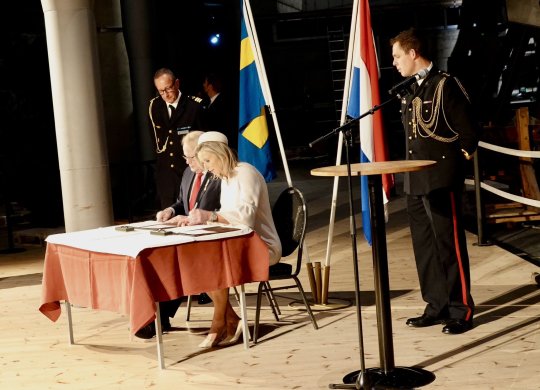

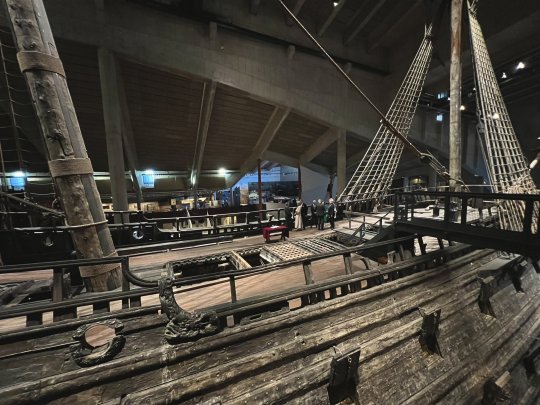
Dutch State Visit to Sweden - Day 1
In the Vasa Museum, the royal company is given a tour of the restored warship the Vasa. Subsequently, the defense ministers of the Netherlands and Sweden sign an agreement to intensify mutual cooperation. Oct. 11, 2022.
📷 Royal House of The Netherlands
16 notes
·
View notes
Text
Caribbean Currency 2
Continuing from the last post I made.
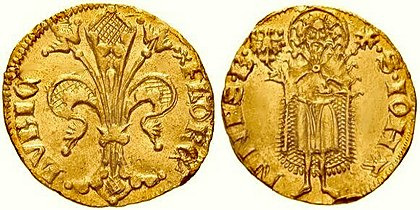
(Pictured: Florentine Guilder from 1341)
So I did a bit more reading around, mostly in the interest of grasping living wages and cost of living in the 17th and 18th centuries. In doing so I came across more in depth information about Dutch currency beyond the Lion Dollar, namely the Guilder.
Guilder, which is the English term for Gulden, which is German and Dutch for just “golden”, an informal term for “gold penny”. It is largely considered interchangeable with the Florin, as the currency was widely used all across the reach of the Holy Roman Empire. Anyway.
A Guilder was essentially worth half a Lion Dollar. Recall earlier, a Lion Dollar is worth between 4 and 5 Shillings in English currency. It takes 20 shillings to make a pound, thus 4 to 5 Lion Dollars to make a pound. Hence, it takes about 10 guilders to make a pound, so a Guilder is roughly equal to 1/10th the value of the pound or English Guinea. This is all noteworthy because the Guilder was the long accepted go-to currency for foreign reserves, likely due to its equal value and standing with the Florin and its widespread use across central Europe.
In reading on all this, I too found the values of ships were often rated in tonnage. Specifically about 20 pounds to the ton. Using some ships in Devil’s Eye for a quick reference...
La Demonia Roja, a massive Manilla Galleon, weighs in at 1000 tons of storage, giving it a massive value of 20,000 pounds.
The Barracuda, a simple schooner, weighs in at a mere 100 tons, giving it the value of 2000 pounds.
The Barracuda’s long standing rival and competitor from their piracy days, the Dutch vessel Diantha, being a converted Fluyt (a ship with a unique design meant to maximize tonnage without taking up too much area), weighs in with 400 tons for a value of 8000 pounds.
The HMS Cavalier, a 6th Rate warship oared frigate captained by an old former friend of Ravyn Hurley’s father, Post-Captain Jack Davenport, weighs in at 300 tons for a value of 6000 pounds.
For comparison’s sake, the annual wage of the First Lord of the Treasury of England was 4000 pounds. It’s a little sad that Ravyn’s pride of a ship is worth less than that, but such is life. Middle class wages were expected to be anywhere between 40 and 75 pounds a year, which is about what would be expected for a merchant trader who owned a ship. Given the costs of a ship and hiring a crew to captain and sail the ship, the loans must be outrageous. Despite that, a ship was a long term investment that often paid for itself several dozen times over several decades of use, which is why piracy for stealing such vessels was a lucrative business to begin with.
Other notable wages and fees of the 17th and 18th centuries include:
Coach rides were 5 pence per mile if you rode inside the coach, and 2 pence per mile if you rode on the outside.
River ferrying was about 3 pence per mile.
A cheap shared bed at an inn would cost you 2 pence a night - but an unfurnished room for rent would only cost 1 shilling a week, so it was actually cheaper to pay by week if you were staying over long term. (Things like this are again, why Ravyn needs Robert around to manage the crew’s finances!)
Servants only made between 2 and 5 pounds a year in earnings, but their estate would pay for their clothing, food, and board, which were the most common and costly expenses of living at the time. A more experienced housemaid could make up to 8 pounds a year, and an exceptional housekeeper could make up to 15 pounds a year.
Lastly, it was generally assumed anyone making 500 pounds or more a year were considered wealthy to some degree or another. I don’t know how far up one must go the wealth ladder to be considered nobility or aristocracy, though.

As for the money the Heyder family pulls in, I’m still working that out. I’m imagining Robert having a fairly large amount of disposable income, but not enough to where he can just liberally throw money at any and every problem he comes across. Otherwise it would start begging some questions. I’ll get back to that later.
#OOC#real history#given the Heyder family's closeness with the Hawthornes#and the fact both of Robert's sons work jobs#it wouldn't make sense for the family to be fabulously wealthy#but they are more comfortable than most#again im still working on it
6 notes
·
View notes
Text

Dutch F-35 fighters intercept three Russian aircraft over Poland 🇵🇱
Fernando Valduga By Fernando Valduga 02/14/23 - 09:00 in Interceptions, Military
Two Dutch F-35 fighters performed a first interception while deployed in Poland. Earlier today, the Dutch rapid reaction alert (QRA) was activated to identify an aircraft formation in Poland.

The two fighters were aird to identify and escort the formation of then unknown aircraft approaching the area of responsibility of the Polish NATO of Kaliningrad. The mission was supported by Eurofighters jets of the German Air Force.

After identification, it was discovered that there were three Russian aircraft: an IL-20M Coot-A that was accompanied by two Su-27 Flankers fighters. The Dutch F-35 escorted the distance training and delivered the escort to NATO partners.
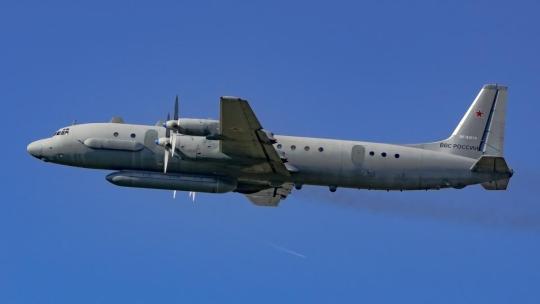
Russian Il-20 "Coot" aircraft intercepted by Dutch F-35s.
There are eight Dutch F-35 fighters in Poland that will remain in the months of February and March. Four of these combat aircraft are available at Malbork Air Base for surveillance of NATO airspace above Eastern Europe. When necessary, days aircraft take off in minutes to intercept another aircraft. This happens, for example, when an aircraft approaches NATO airspace without identifying itself. Two F-35s are on reserve for this task.

An ally training program is being completed with the other four combat aircraft. Of course, these can also be used immediately if the situation so requires it.
Tags: Military AviationF-35 Lightning IIInterceptionsNATO - North Atlantic Treaty OrganizationRFSAF - Russian Federation Aerospace Force/Russia Aerospace ForceRNLAF - Royal Netherlands Air Force / Royal Dutch Air Force
Fernando Valduga
Fernando Valduga
Aviation photographer and pilot since 1992, he participated in several events and air operations, such as Cruzex, AirVenture, Dayton Airshow and FIDAE. He has works published in specialized aviation magazines in Brazil and abroad. He uses Canon equipment during his photographic work in the world of aviation.
Related news
VANT - UAV
Polish Armed Forces receive rented MQ-9A Reaper unmanned aerial vehicles
02/14/23 - 17:00
Northrop Grumman demonstrates its next-generation gateway system on a Triton flight test platform. This multiplatform and multi-domain capability on the Triton platform reinforces the Navy's interoperability to help enable distributed maritime operations. (Photo: Northrop Grumman)
MILITARY
Multiplatform demonstration presents interoperability between F-35, MQ-4C, E-2D and warships
02/14/2013 - 16:00
HELICOPTERS
India's HAL prepares for future orders with 'Asia's largest helicopter factory'
02/14/23 - 15:00
MILITARY
Hensoldt receives a 100 million euro contract as part of the FCAS program
14/02/2023 - 14:00
MILITARY
NORAD explains the reason for so many appearances of "unidentified flying objects" in North America
14/02/2023 - 12:00
Sikorsky delivered two CH-53K helicopters to the U.S. Marine Corps in December 2022. Heavy-duty helicopters will be based at the New River Marine Corps Air Station in Jacksonville, North Carolina.
HELICOPTERS
Sikorsky delivers two more CH-53K helicopters to the U.S. Marine Corps
14/02/2023 - 11:00
8 notes
·
View notes
Text
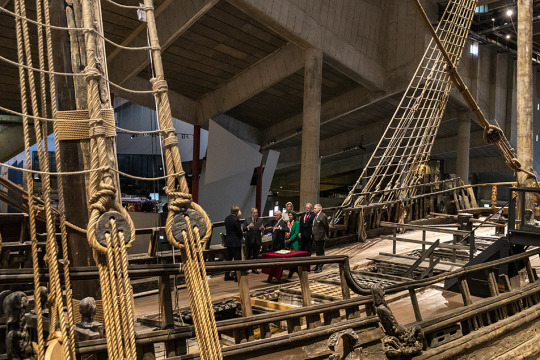
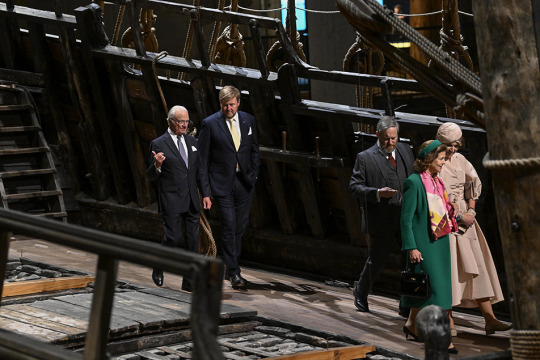

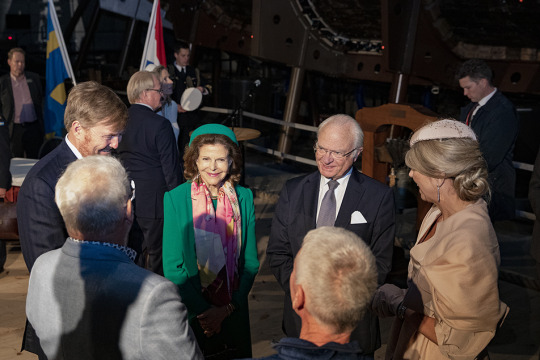
Sweden: The Sweden/ The Netherlands State Visit Day 1
On October 11, 2022, the State Visit to Sweden from the Netherlands commenced. After the King and Queen of the Netherlands were received by members of the Swedish Royal House at the Royal Palace in Stockholm, they joined the King and Queen of Sweden. King Carl XVI Gustaf of Sweden and King Willem Alexander of the Netherlands gave speeches regarding the State Visit. This was was followed by a lunch for the King and Queen of Sweden and the King and Queen of the Netherlands at the Royal Palace. The Royal Couples, then conducted a visit to the Vasa Museum, which houses the 17th century War Ship (the Vasa), which remains fully intact in the museum, after it’s sinking in 1648. At the Vasa Museum, the King and Queen of Sweden and the King and Queen of the Netherlands were able learn about the ship and were even shown aboard it. The visit to the museum also resulted in the Dutch King and Queen, receiving a valuable bell from the shipwrecked warship, called Sophia Albertina. This ship sank in 1781 off of the Dutch Coast.
pc: kungahuset
#king carl xvi gustaf#queen silvia#king willem alexander#queen maxima#sweden: netherlands state visit
10 notes
·
View notes